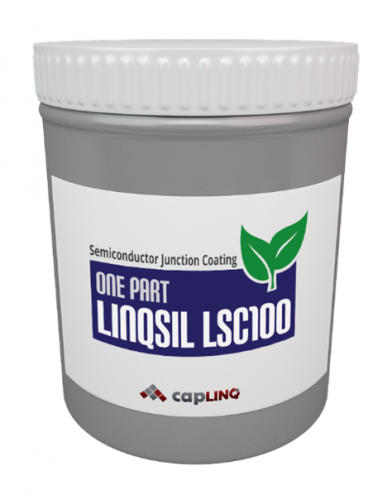LinqSil LSC100 One-Part Liquid Silicone Semiconductor Junction Coating
- One-part liquid silicone coating
- For protection and passivation of semiconductor junctions
- Ionic purity levels of max 1 ppm
Product Description
LinqSil LSC100 liquid silicone junction coatings, are high purity, 100% solids, siloxane systems designed for semiconductor junction coatings. The LinqSil LSC100 coatings are one-part silicone coatings with a heat cure. Demanding production procedures and rigid quality control requirements guarantee ionic purity levels of maximum 1 ppm.
LinqSil LSC100 junction coatings will prevent electrical breakdown, minimize junction surface leakage and stabilize peak inverse voltage, and provide environmental protection for high temperature performance and thermal cycling. LinqSil LSC100 is designed for passivation coating of transistor, diode and rectifier junctions.
Typical applications of the LinqSil LSC100 liquid silicone coating systems include conformal coatings that are used to provide mechanical and electrical insulation prior to plastic molding, protective coatings over hybrid integrated circuits to prevent chip damage during potting and other ultra-pure, hermetic-type passivations of semiconductors to create a shell against corrosion.
Technical Specifications
| General Properties | |||||||||||||||||||||||
| Appearance Appearance Appearance at room temperature. | Clear | ||||||||||||||||||||||
| Color Color The color | Clear | ||||||||||||||||||||||
| Solids | 100 % | ||||||||||||||||||||||
| Specific Gravity Specific Gravity Specific gravity (SG) is the ratio of the density of a substance to the density of a reference substance; equivalently, it is the ratio of the mass of a substance to the mass of a reference substance for the same given volume. For liquids, the reference substance is almost always water (1), while for gases, it is air (1.18) at room temperature. Specific gravity is unitless. | 1.03 | ||||||||||||||||||||||
| System | One-Part Siloxane | ||||||||||||||||||||||
| |||||||||||||||||||||||
| |||||||||||||||||||||||
| Physical Properties | |||||||||||||||||||||||
| Viscosity Viscosity Viscosity is a measurement of a fluid’s resistance to flow. Viscosity is commonly measured in centiPoise (cP). One cP is defined as the viscosity of water and all other viscosities are derived from this base. MPa is another common unit with a 1:1 conversion to cP. A product like honey would have a much higher viscosity -around 10,000 cPs- compared to water. As a result, honey would flow much slower out of a tipped glass than water would. The viscosity of a material can be decreased with an increase in temperature in order to better suit an application | 7500 mPa.s | ||||||||||||||||||||||
| Electrical Properties | |||||||||||||||||||||||
| |||||||||||||||||||||||
| Dielectric Strength Dielectric Strength Dielectric strength is measured in kV per mm and is calculated by the Breakdown voltage divided by the thickness of the tested material. Those two properties go hand in hand and while Breakdown voltage is always thickness dependent, dielectric strength is a general material property. As an example, the dielectric strength of Polyimide is 236 kV/mm. If we place 1mm of Polyimide between two electrodes, it will act as an insulator until the voltage between the electrodes reaches 236 kV. At this point it will start acting as a good conductor, causing sparks, potential punctures and current flow. | 17.7 kV/mm | ||||||||||||||||||||||
| Volume Resistivity Volume Resistivity Volume resistivity, also called volume resistance, bulk resistance or bulk resistivity is a thickness dependent measurement of the resistivity of a material perpendicular to the plane of the surface. | 1.0x1015 Ohms⋅cm | ||||||||||||||||||||||
| |||||||||||||||||||||||
| Mechanical Properties | |||||||||||||||||||||||
| |||||||||||||||||||||||
| Elongation Elongation Elongation is the process of lengthening something. It is a percentage that measures the initial, unstressed, length compared to the length of the material right before it breaks. It is commonly referred to as Ultimate Elongation or Tensile Elongation at break. | 130 % | ||||||||||||||||||||||
| |||||||||||||||||||||||
| Other Properties | |||||||||||||||||||||||
| |||||||||||||||||||||||



